MEDIEVAL ARMORS. HISTORY AND EVOLUTION.
The medieval armours were a essential element for the middle age knights, protecting them in the assaults that they could suffer with swords or other weapons. From the antiquity when the man had to face a hand-to-hand combat, they tried to protect them somehow, first with animal skin, then leather, and finally with metals, with armors.
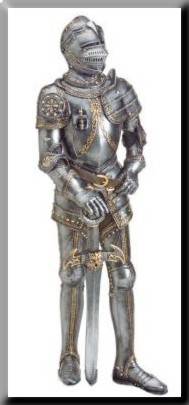
The medieval armours have evolved through time, overcoat on the protection and decoration.
So, we can call medieval armor to the set of pieces used for the defense, made with steel (or some other metal) that covered the bodies of the middle age and beginning of the modern age knights completely. The armors of the knights were used in the combats, tilts and warlike clashes, so the armors helped them a lot in their defense, to receive the minor possible damage

Axes, lances and swords were one of the most effective medieval weapons
We can say that the beginning of armours use was in Egypt in 4.000 b.C. The materials that were used in most of the armors was crocodile leather and leather reinforced with bronze . This materials to make the armours have evolve trough time, beginning with leathers and bones and coming up to the use of metals.
The first pieces that were made for the protection were destined to the weakest and defenseless zones of the body, or the parts where a wound could easier cause the warrior death, like the head or the trunk, that was the first thing they protected. They started using the "camisotes" (the evolution of the belts) made with buffalo skin that were reinforced with metallic scales, some of them coming up to the hip and longer ones coming up to the feet. Some knights also used shinpad in order to protect the front part of the legs.
The zone of the head and proximities was starting to protect because the shield did not cover it completely. It is necessary to say that the helmet was the piece that characterized the knight, metals were used to make them and they drew adornments to stand out between the others. Sometimes they reinforced them with bronze or wild boar tusk because where lighter.
During the first millennium b.C, in the ancient Egypt, the "camisotes" came from the axillas to the knees and were supported to the shoulder with straps. This straps were made with leather, reinforced sometimes with quilts, broad metallic sheets and even with bronze scales (some of them with more than 20 cm. width). The warriors used for the first time with the shinpad metal rings to cover the arms.
In the XV century b. C. stars to appear armours covering the torso, this ones were made with animal skin where they set bronze pieces, were called scales or loricas armors. On the other hand they started to use shinpad with metallic sheets to cover the legs and a big belt to protect the abdomen. Also in this century in Syria they started to strengthen the traditional suits. They used long-sleeved shirts covered with bronze scales (sewed in flexible sheet rows), that were used as armors, this was made because in a lot of occasions they moved in carriage and could not take shields because they had hands occupied driving the carriages.
Later the Greeks developed these armours making forge or metal one piece breastplates and back bars, one piece on the other one with quilts reinforcement and also with shinpad to cover the legs
In the time of Greek magnificence, the lower part of the body was not protected and either the lower part of the legs (was covered only with a skirt with loose strips) not even the right arm because they supposed that this zones were safe for the skill of the warrior in the hand to hand combat and the protection of the shield. The shield was very important, not only protected the left arm it also protected the heart zone.
The Iberians used an armour with discs to protected mainly the chest. The Samnitas (warriors of the Italic villages) used disc cuirasses but this ones covered more part of the chest zone. The Celts on the other hand used breastplates that covered the torso and the shoulder zone, and the helmets sometimes were decorated with geometric finished where they added some feathers.
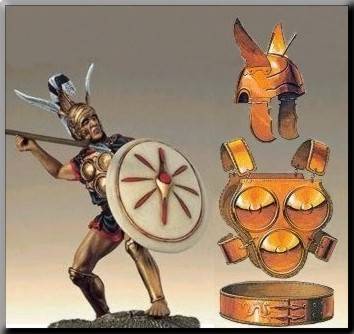
The Samnitas warriors protected the chest zone with disc armors
In Rome the light infantry (Vélites) like the Samnitas and later the gladiators wore shinpad on the left leg, while the hastatos (middle class men who formed the heavy infantry) wore them on the right leg, depending of which leg moved forwards in the combat.
About the trunk zone, the Romans used the metal scales (and also bones and horns) that they sewed. This one covered the chest, back, abdomen, hips and shoulders and in the heavy cavalry soldier case used a similar armor that covered also feet and hands.
During the Republic the lorica was reduced quite a lot, without sleeves, and covering only up to the hips, covered with a net of small and tight rings of iron, nevertheless during the imperial time a more malleable cuirass was made formed with broad sheets of steel covering the whole trunk that gave more freedom to the soldier. But the more known piece of the Roman Empire was made of two pieces, the breastplate and the wall bars. Both of them adjusted to the body giving more movement freedom. Regarding to the helmet, seemed Etruscan, had nape-guard and jugular.
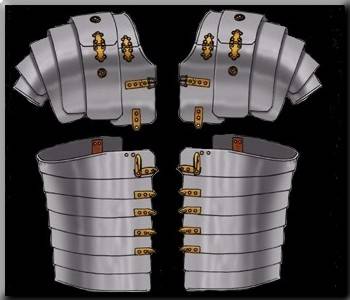
The highest inconvenience of the roman lorica was that the axillas were not covered.
After the Roman empire declivity there was development decline of the armours. We can say that the development started again from the beginning, using clothes that only protected from swords, daggers, axes, halberds and lances.
The German and Francs warriors used leather smocks without sleeves or quilt cloth, in the XIII century they added more rings, mails and metal sheets even with metallic streeps that formed a latticework finished off in the hollows with thick nails. They called this lorica, which come up to the hips, although in the X century they covered also the thigh up to the knee and after they added sleeves that came mainly up to the elbow and later they added sleeves that came up to the wrist, hands were still not covered. In the German and Franc villages the helmets were a simple wide-brimmed hat, did not have visor or jugular, starting the X century they added a rectum nasal.
In Spain the Visigoth invaders used the lorica (with steel hoop) and the helmet. Also they started to use quilted garment (tight shirt that covered from the shoulders to the waist), also called aketon, so the body was protected from frictions that could produce the lorica or knocks that could weaken the soldier.
There were also the Normans that wore a longer and tight lorica that covered the knees and arms up to the wrists. They started to separate the sleeves and the breeches in different pieces that were held to other with clasps and straps. The neck and the nape were covered with a hood of mail placed under the helmet or the basinet. If this pieces were together they were called basinet with channel.
The first important developments that suffered the armors were that the loricas disappeared (they left without protection the axillas), so they are replaced for the coat of mail, this happen in all Europe about the XI century. This coat of mail was formed by forged rings and have an small diameter, was made with a leather base reinforced with metallic discs. The disadvantages were, they were very expensive ( and that is the reason why only nobles could use it) and the other reason was that they were very heavy , approximately eleven kilograms.
Metal was improving to get to the mild steel, stronger and more malleable. This way the plates armors appear, handcrafted by master armourers. The first complete piece that extended was the breastplate even thought the pauldron also had an important evolution to adapt to it articulated sheets to make easier the movement whereas the face was protected with the rondel and the neck with the gorget.

The coat of mail was made by the union of small metallic discs
The breastplate was every time shorter to facilitate the movement of the warrior while he was riding, this left the stomach unprotected, but this was solved with a articulated pieces called loin-guard. But still the hips were unprotected, so a new piece was invented to cover the hips, called tasset. The crotch was also unprotected and this was solve with the carajera.
To fight the heat effect and overcoat as decoration, from the second crusade, a coat of arms without sleeves to which the sword belt was united to hang the sword. Soon this sobrevesta, like the helmet and the shield was decorated with signs and figures to distinguish the knight and later would have an heraldry meaning (coat of arms). To prevent frictions in the face and neck of the knight this wore a cup or a quilt cloth hood whose tops were tied up under the beard, this garment could be dyed with the favourite colours of the knight that soon formed part of the shield too.
Protection for specific zones were introduced, for example, leather gloves, were covered with mails or small metallic pieces, also mail stocking and mail sock, elbow-cods, knee-cops, cuishes and pauldrons, placed on the doublet. All the visible zones of the knight were covered with steel plates, except for the low part of the thighs and the buttocks that were protected by the saddle and the horse.
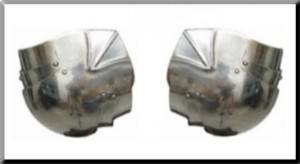
The Spanish medieval armours were improved with the use of specific pieces , for example, the elbow-cod to protect the elbows
For the people that could not afford this kind of armors were made two different types on the XIV, XV centuries and the beginning of XVI. Were the jacerine on one side and the brigandine in the other. The first one very used in oriental Europe, made with metal sheets joined to a interior cloth suit and the second one was the same as the jacerine but in the inverse order, the sheets were rivet inside of a jubom with brilliant colours, finished off with carved and golden stud heads. This protections were very common in Spain and Italy.
The armour of plates (habitually called) appears on the XIV century, at the end of the century called white harness, the harness that all knights wanted. An armour could have more than 250 pieces and weigh 30 kilograms. Though this pieces did not have always a precise name we can list some of the more common parts of the armour ( or plates armour like they were traditionally named).

The medieval armour could be formed for more than two hundred pieces
- The helmet or similar, to, protect the head. Sometimes the helmet had a visor to cover the face.
- The bevor to protect the mouth, chin and jaws.
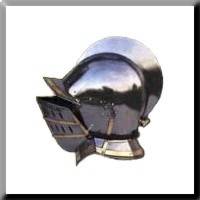
With the bevor they protected the mouth and jaws part
- The gorget to cover the neck, and lower part of the chest and breast.
- The nape-guard to protect the zone from the neck to the shoulders.
- The clamshell close helmets, were closed helmets. This helmets were formed for the crest (to decorate the upper zone), the helmet (to protect the head) and the collar (adorns all the low circumference of the helmet). This was the more expensive piece because was the piece that protected the most important zones of the brain.
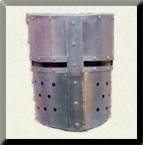
The clamshell helmet was the same as the helmet but completely closed
- The ventalle was the mobile piece, next to the visor to close the previous part of the helmet.
- The aventail, covered the neck and shoulder but given mobility.
- The lance-rest , was a iron piece in the breastplate armor to hold the lance.
- The breastplate to protect the breast.

The breastplates were adapting and becoming shorter to allow the warrior to move easily
- The backplate, to protect the back.
- The loin-guard to cover the waist and hips.
- The tasset, it was longer that the loin-guard and was tied to it.
- The escarcelones, like the tasset but bigger, that extended with joints up to the knees.
- The guardarrenes, was an extension of the backplate, developed to protect the lumbar part.
- The pancera, for the abdomen and the stomach.
- The brayette, to protect the crotch.
- The culet, for the gluteus, made with horizontal strips.
- The pauldron, to cover the shoulder blades (sometimes they covered also the front part replacing the bufas).
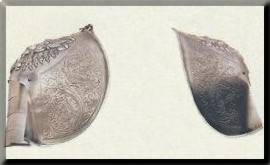
The pauldrons were one of the specific pieces of the medieval armour to protect the shoulder zone as its name indicate.
- The gardbrace, to protect the upper part of the arms.
- The besagew, to protect the front and back part of the armpit.
- The couter, to protect the elbow.
- The rerebrace and vambrace, to cover the arm and forearm.
- The cangrejos, for the opposite part of the elbow.
- The gauntlet, with mobile pieces for each finger to protect hands and wrist

The gauntlet were made every time more comfortable for the warrior, the fingers zone was articulated.
- The bufas, to protect the clavicle zone.
- The cuisse, to protect the thighs.

The cuisses were to protect the thighs zone
- The knee-cop , protecting the knees, almost always accompanied by some pieces around of the knees to protect the sides from lateral knocks
- The greaves, for the lower part of the legs, sometimes they had articulated greave stocking to protect the lower part of the knees.
- The solleret , to protect the instep, they also used ironwork shoes to protect feet.
- The target, was a shield on the left upper zone of the breast-plate with the knight emblem.
The first piece that a knight should place when they dressed with the armour was the coat of mail (this could have a hood under of the helmet). After the coat of mail goes the gorget then the breastplate and the pauldron. In the legs zone they had to start on the feet zone. They held the pieces with straps, hooks, nuts and nails. When they finished to put the armour their weight was 30 or 40 more kilograms, sometimes more. Because of this the knight could not move easily, this knights were unbeatable but on the other hand they could not move. To set up all the armour the knight needed a squire to help him to dress and undress and get on the horse. They were assiduous companios and servants, they cleaned the armours, the weapons and were guardians of their goods and also slept close to them as guardian. They also cured their injuries and in the case the knight died the squires were in charge of the funeral.
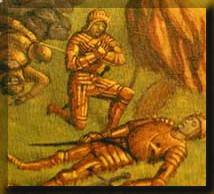
The squires had to help the knights, even, cleaning the armour and the weapons
A knight with a medieval armour was nearly unbeatable, but if the knight fell down on the floor would be really easy to defeat, due to the weight of the armour would be very difficult for the warrior to get up and to move easily.
To fight they used horses with armours to be able to defend from the soldiers attack. On the XII century some horses had an armour. The pieces used for the horse armour were very similar to the knight armour . first they used leather, then mail and finally, metal. The horse armours were diverse, with different shapes and styles and sometimes even nicer than the warriors armour.
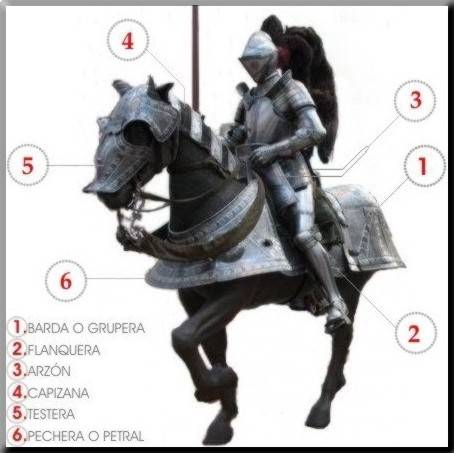
Parts of a medieval horse armour
Some of the pieces of horse armour were:
- The chanfron, to protect the horse head.
- The crinet, to protect the neck of the horse.
- The peytral, to protect the chest zone, on this piece is were the heraldic emblem could be.
- The flanchard, to protect the sides zone of the horses.
- The crupper, To protect the croup or the back part of the horse.
- We also can name the pommel, is the part joined to the saddle, though its function was to protect the warrior more than to protect the horse. The function was protect the warrior from knocks in the genital zone.
On the XV century come the peak epoch of the combat armours, this armours were called Gothic armour, with smooth zones and shiny, with suggestive curves and decorated, but not too much only in the edges. The breastplate, helmet, arm and leg zones had clefts and strips, while the fingers and feet zone were made broader. The armours of this epoch were one of the most magnificent and though they made this armours to fight never again were made so splendid armours. During this century the warrior was completely armed and completely wrapped in the armour.
We could not talk about armours without the gunsmith, the people who create the armours. This trade come from time before and had a lot of importance during the Roman empire. A lot of complete families worked making them. The first thing that was made in this process was the forge then they polished it and assembled the pieces, placed the straps, lining and padding, in case they had shield or emblem it was engraved and adorned, some of them with gold. The most traditional way of decorate the metal was engraving it, was a difficult and hard process. We also can talk about the heraldry, were emblems to distinguish the knights in the battlefield. Each nobleman had his own coat of arms that was stamped in the shield and flag. Emblem was individual. This way was possible with the different emblems to distinguish the enemies.

The gunsmith were in charge to make the medieval armors engravings
The use of armours was falling down in declivity, this was caused by the invention of the gunpowder, the armours did not have any more the utility that they were created for, face to face combat . Now the combats were distanced. The gunpowder was discovered on the XI century in China, but they used it only for fireworks or similar. The European were who discovered and developed the most destructive uses. At the begin of the XIV century, appeared the first fire weapon , this was a cannon that projected lances, later they started to use stone and iron bullets.
Some interesting places were we can see some of this armours are: The royal gunsmith in Madrid, in the army museum of Paris, in London tower, in New York or the historical museum of Vienna.
We can mention some anecdotes about armours, for example, when a warrior wanted to get on the horse they needed a crane because the warrior was not able to get on the horse on his own. The armour weigh was minimum 35 kilograms, but this could vary a lot, they could dress with more than one armour, one on the top of the other one. Sometimes warriors death cause were heart attacks or embolisms, also the food aten before the battle. The horses were trained specially to be stronger and lighter, but because of the weigh of the warrior the mobility was also reduced.

Toledo knight and horse with medieval armor.
 Cookie preferences
Cookie preferences

 WhatsApp
WhatsApp
 Call us
Call us
 FAQs
FAQs